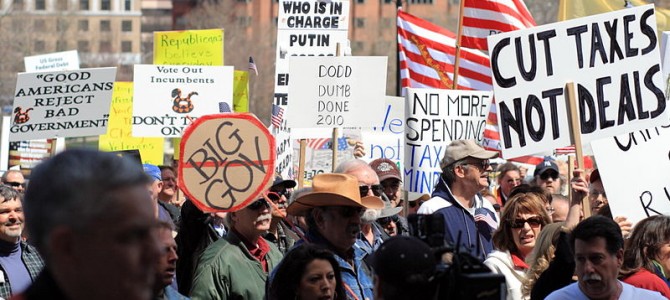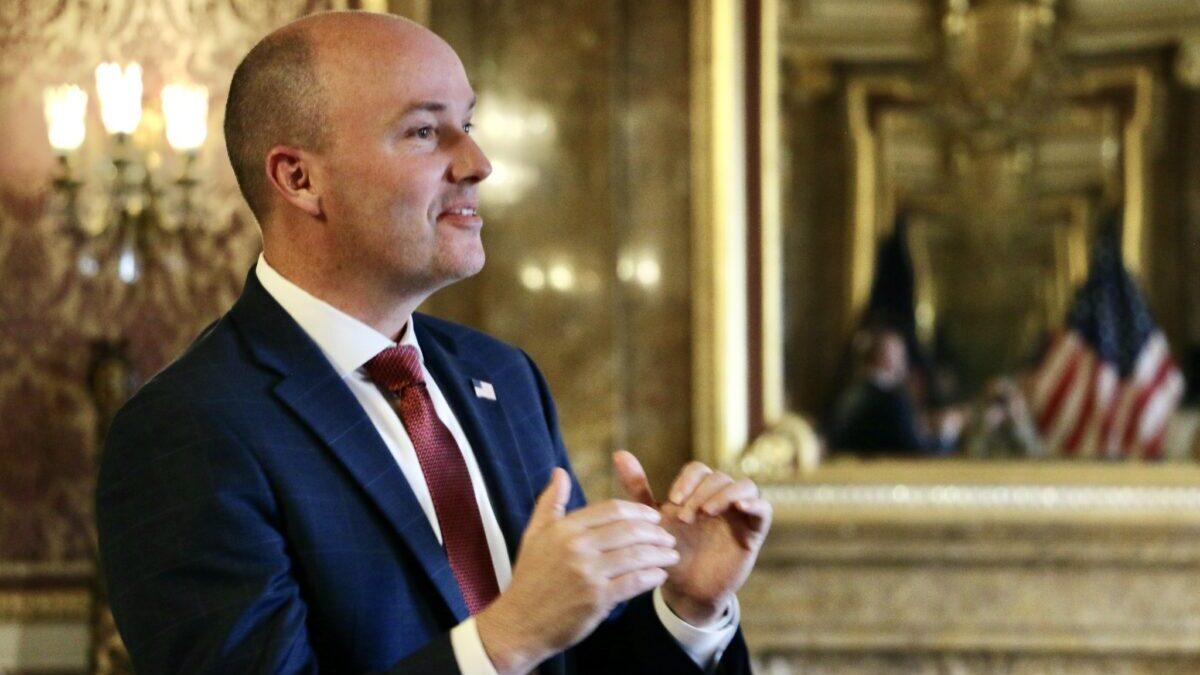
It has been five years since the Tea Party movement broke out as a national phenomenon.
It began, of course, with Rick Santelli’s “rant heard ’round the world” in February of 2009, which brought widespread attention to the idea of a modern revival of the revolutionary anti-tax fervor behind the Boston Tea Party. But the early rallies were small and largely attracted the same old die-hard right-wing activists, rather than drawing in new people.
I didn’t know whether the Tea Party would become a real phenomenon until April 15, 2009—Tax Day being a perfect time to protest big government—when there were hundreds of rallies across the country attracting hundreds of thousands of people.
I knew it when I was heading over to our local Tea Party rally in Charlottesville, Virginia. Four or five blocks away, I saw throngs of people walking toward the event holding the homemade signs that would become one of the emblems of the movement. Charlottesville is not a very big town, and it’s a university town, too, so it trends left. This sort of thing had never happened before.
This was before Congress had taken up ObamaCare, mind you, so these people were protesting against the bailouts and the “stimulus” and the massive expansion of government in general. When ObamaCare was added to that agenda, it was just gasoline added to the fire.
Today, five years later, Tea Party rallies are less frequent and much smaller, and the Tea Party movement has become less visible. This is prompting some on the left (not to mention establishment Republicans) to gloat that it has withered away.
They’re not exactly in a position to gloat, given how quickly Occupy Wall Street dissolved into embarrassing anarchy. And does anyone even remember the Coffee Party? By comparison, the Tea Party is a grass-roots uprising that has been much larger and had a lot more political impact and staying power.
So what has really happened to the Tea Party five years on?
To get an idea, I called up my friend Carole Thorpe, who discovered the Tea Party movement the same time I did, at the big Charlottesville rally five years ago today, and who for most of the past five years has been the organizational backbone of the Jefferson Area Tea Party. Like many Tea Partiers, she was not actively involved in politics before, so she was part of the grass-roots upswell.
Carole agreed with me that most attempts to look at the Tea Party’s legacy have focused too narrowly on its impact on national-level electoral politics. That even includes some of the positive assessments. John Fund, for example, concluded that the Tea Party is thriving because Republicans are likely to take control of the Senate with this November’s election.
That’s an inside-the-Beltway perspective, viewing the Tea Party merely as shock troops for traditional electoral politics. But the Tea Party was never about electing Republicans. In fact, the movement has had a hostile relationship with the Republican establishment, which it views as bearing responsibility for the unchecked growth of government during the Bush years.
Yet the Tea Party did help elect Republicans, and that’s one reason why the movement is less visible now. The immense wave that brought Republicans back to a strong majority in the House in 2010 was an undeniable victory for the Tea Party, particularly since these Republicans were more radical on average than the previous ones. What is less appreciated is that 2010 was also a Republican wave in the state legislatures. But success took away some of the movement’s urgency.
Remember that Nancy Pelosi’s strategy for winning a House majority in 2006 was to recruit conservative Democrats to run in right-leaning districts. On the campaign trail, they would sound like they shared the values of their constituents, but once in DC they would be reliable votes for Pelosi, Barney Frank, and the rest of the far-left Democratic leadership. This meant that there were a lot of districts represented by “Nancy Pelosi Democrats,” whose constituents were future Tea Party sympathizers. Once the Tea Party movement activated these voters and got them engaged in the election, it swept dozens of Democrats out of office.
Take Charlottesville. It may be a left-leaning university town, but it’s part of Virginia’s fifth congressional district, which includes Lynchburg (home to a very different university founded by Jerry Falwell) and large swathes of Virginia’s rural Southside, so the district as a whole is much more conservative. In 2008, Democrat Tom Perriello defeated the Republican incumbent by about 800 votes, in the best election year for Democrats in a generation. He was unlikely to keep that margin and was duly booted out in 2010.
Once that was finished, many Tea Partiers could reasonably conclude that, when it came to national politics, they had done their bit. They had fired the folks who voted for bailouts and runaway spending and ObamaCare and put in new representatives who promised to oppose all of these things. So we shouldn’t be surprised that the movement lost some of its momentum. It lost momentum by winning.
On the Senate side, however, the story has been less happy. There, the Tea Party has focused more of its effort on mounting primary challenges against moderate, pragmatist, establishment Republicans. There were a few notable successes—getting rid of Charlie Crist in Florida, for example, or replacing Bob Bennett with Mike Lee in Utah. But there were also high-profile flops, Tea Party candidates where weren’t ready for prime time.
Here in Virginia, the biggest Tea Party failure was last year’s governor’s race. I think it’s safe to say that nobody was better loved by the Tea Party than Ken Cuccinelli. Yet he lost to a corrupt Clinton political fixer. Local Tea Partiers complain that he was badly underfunded and not well supported by the national Republican Party, which gave him about half the money they invested in his predecessor, Bob McDonnell—who rewarded Republicans with a crony capitalist bribery scandal. Yet this underscores the limitations of the Tea Party when it comes to large-scale electoral politics. As Carole Thorpe put it, “The Republican Party by its nature is a huge machine. Because the Tea Party is grassroots, we’re not a machine. The fact that we’ve had any victory in that area is tremendous.”
But as Ben Domenech points out, success in electing candidates isn’t everything. The main thing is success in influencing the political agenda. In this respect, just the fear of a Tea Party primary challenge can be successful in moving a politician to the right, emboldening him to cast votes the Tea Party will like and making him afraid to cast votes they won’t like. After all, what Republican politician wants to court trouble with his conservative “base”?
Carole describes the Jefferson Area Tea Party’s post-election agenda as “keeping a pretty close eye on Robert Hurt,” the Republican who replaced Tom Perriello in Congress. The difference is that she has found Hurt to be open to her arguments. “Tom Perriello would smile at you and tell you what you wanted to hear, and then go off and vote however he wanted to,” whereas Hurt has been “doggedly insistent on [opposing] ObamaCare, which is the #1 thing” for the Tea Party.
But even this misses the main action in the Tea Party movement these days: it has gone local.
In the Virginia General Assembly, every bill is read by someone in the state’s Tea Party consortium, and Tea Party groups go down to Richmond to lobby for their agenda almost every week while it’s the Assembly is in session.
So far, they’ve helped encourage Republicans to block the Medicaid expansion demanded by the new Democratic governor. This is a key part of the state-level implementation of ObamaCare, and since it’s not going to pass on its own, Democrats are trying to tie it to the state budget. They are following the national template of trying to win the issue by forcing a government shutdown.
Carole describes the Tea Party’s role: “We’ve seen this movie before. They can only win when Republicans cave.” So Tea Party groups are “sending busloads” of activists to stiffen their resolve.
The enormous growth of the federal government has had the effect of decreasing scrutiny on state governments, as press coverage and public attention tend to get sucked up by national controversies. But this actually makes the Tea Party more effective, if they choose to focus on what’s happening in the statehouses. When state lawmakers hold public meetings, and the Tea Party groups are the ones who are always there, they’re going to get the attention and influence.
Carole notices the same thing, but even more so, on the county and city level, where “20 passionate people showing up can make a difference.” When the county Board of Supervisors put forward a plan to hike property taxes, ostensibly to pay for the schools, there were only two groups who regular showed up: teachers and the Tea Party, without whom the tax proposal would have faced no opposition.
They also managed to block the fast-track approval of a 400-page comprehensive plan for the county’s regulation and spending. (County governments are the only place in the world where Soviet-style central planning, complete with five-year plans, still thrives.) Now the Board of Supervisors will be required to debate each chapter of the comprehensive plan one at a time, with Tea Partiers watching them every step of the way.
The most notable Tea Party initiative on the local level has been its campaign against Agenda 21, a United Nations-sponsored push to promote environmental regulation at the city and county level, supposedly to stop global warming. As you can imagine, this hits two of the big hot buttons for the base of the right: the UN and global warming. The Jefferson Area Tea Party successfully campaigned to get Albemarle County to quit its membership in ICLEI (International Council for Local Environmental Initiatives), a vehicle for promoting Agenda 21. Albemarle was only the seventh county nationally to do this, and the first in Virginia. After activism from local Tea Party groups, hundreds of other counties have followed.
If the Tea Party lives on as a local government watchdog, that will count as a success. But it’s still too soon to say that the Tea Party is done on the national level. It is still a vehicle for launching insurgent primary challenges, and so long as ObamaCare is still on the books, the Tea Party movement will have one big piece of unfinished business. Right now, the Tea Party is in an odd kind of limbo: it’s had enough success to satisfy some of its supporters, yet not enough prospect for future success in its last big agenda item. That agenda will remain dormant until there is a Republican Senate (as now seems likely) and then a Republican president (potentially). If that happens, we will see the Last Charge of the Tea Party on the national level, as they demand that Republicans follow through on promises of repealing ObamaCare.
I expect the career of the Tea Party to be similar to that of the Locofocos, a radical, populist pro-free-market movement that rose up in protest against Tammany Hall corruption in 1835 and was a significant faction of the Democratic Party—how times have changed—for about five years. They dissipated when they achieved their main agenda item, a law separating the federal government from banking (a crusade against special privileges that seems timely again), and many of their members were absorbed into the next big crusade for liberty, the abolition of slavery, and the nascent Republican Party that formed around it.
If that’s the case, the Tea Party movement won’t die from its failures, but from its successes.
Follow Robert on Twitter.









